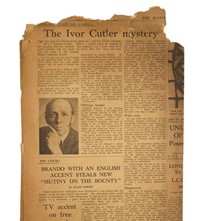As a new exhibition on Cutler opens in London, Another Man remembers the ‘unsung’ Scottish songwriter and poet
- TextAlex Denney
In a documentary on great British eccentrics from 1974, Ivor Cutler tells comedian Dave Allen how he once used a homemade tape recording to startle visitors to a zoo.
“This,” a voice solemnly announced, “is an animal. It has four legs – one at each corner, to keep it up off the ground. It helps it also to see the people who are looking at it over the barrier.”
Was the recording for real? The zoo-goers were unable to tell, says Cutler, recalling with pleasure how the people all stared as if they’d just been “touched up”.
Cutler made it his mission in life to incite odd moments of reflection like this. Through music, poetry and children’s books, the late Scottish songwriter, poet and “unjoiner” of thoughts perfected a brand of eccentric mischief that made him a favourite of The Beatles, Robert Wyatt and the philosopher Bertrand Russell.
His absurdist songs – sung in dour Glaswegian tones with a wheezing harmonium for company – were an ever-present on John Peel’s radio shows, second only in rotation to The Fall. His darkly whimsical eye can be seen in contemporary British artists like David Shrigley and Martin Creed. And yet Cutler remains something of a marginal figure, known only to a devoted few.
“I think he’s definitely undersung,” says Sarah McCrory, curator of a new exhibition on Cutler at Goldsmiths Centre for Contemporary Arts. Drawing on a cache of newly discovered material from Cutler’s archive, Good Morning! How are you? Shut up! assembles a portrait of the artist from a confusion of sketches, posters, poetic fragments and strongly worded letters to hot beverage manufacturers.
“Through all the material you get a sense of what kind of person he was,” says McCrory. “You know, some of it is very frivolous and funny and then it shifts into moments of darkness. It would be easy to imagine that the Ivor Cutler we know is a persona, with his hat and harmonium, but it seems like through all of his material this was him all the time.”
The collection runs the gamut from stickers bearing the legend “This label has no purpose” to a sniffy rejection letter from a man at the BBC named Gerald Savory. Among the carefully curated clutter, revealing details emerge: in one diary entry, Cutler intuits that all his artistic efforts to date have been “a search for simplicity”.
Robert Wyatt, who enlisted Cutler on his seminal Rock Bottom album from 1974, echoes the sentiment in a statement written for the show: “Ivor was, in my opinion, a great artist. His offerings were not presented as ‘high art’, but that’s exactly what they were. He was of course a miniaturist, but that simply means his writings and drawings were highly concentrated, pared down.”
Another musical collaborator, Linda Hirst, remembers Cutler for his kindnesses, and a gift for common sense that no one could have seen coming. “I lived in Tufnell Park from around 1970, and Ivor and I met in the local Greek shop and always said hello,” says the musician, who featured on Cutler’s enduring feminist anthem Women of the World. “We were broken into one day and I told Ivor, so he helped me fill in forms I’d never seen before, gave me tea and was kind.
“A couple of years later he said, ‘Would ye like to make a record?’ Of course I said yes and so we made Privilege for Rough Trade. We stayed friends, of course, and we sometimes met in odd places like John Lewis, and his practical advice was sound and good – rather a surprise when I first encountered it! He was good on washing machines.”
In another piece from the exhibition, a poem entitled Get off the Road, Cutler devises a hymn to unreason that could almost pass for a personal credo. It’s an unexpected moment of pathos from a lifelong pilgrim on the path less trodden. “See the road lying / pressed along the ground / with no beginning or end / like a conjunction / like ‘and’, only longer / Don’t walk on it / For God’s sake, don’t walk on it!”
Y’Hup is at London Goldsmiths CCA until November 4















